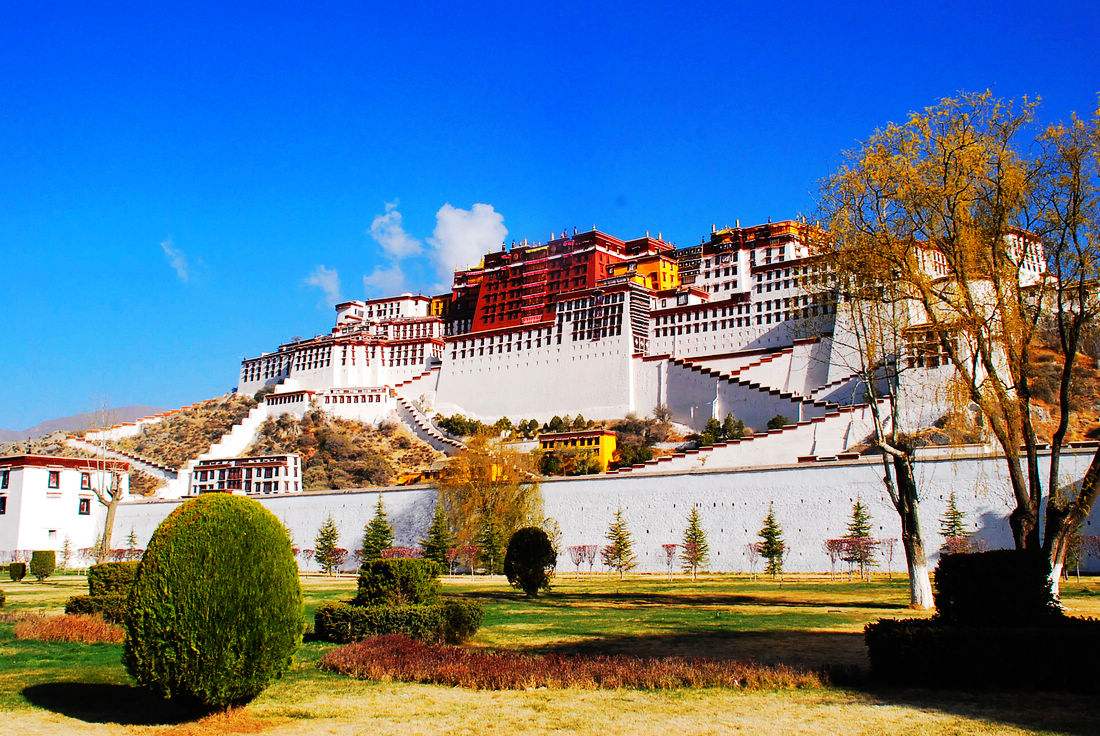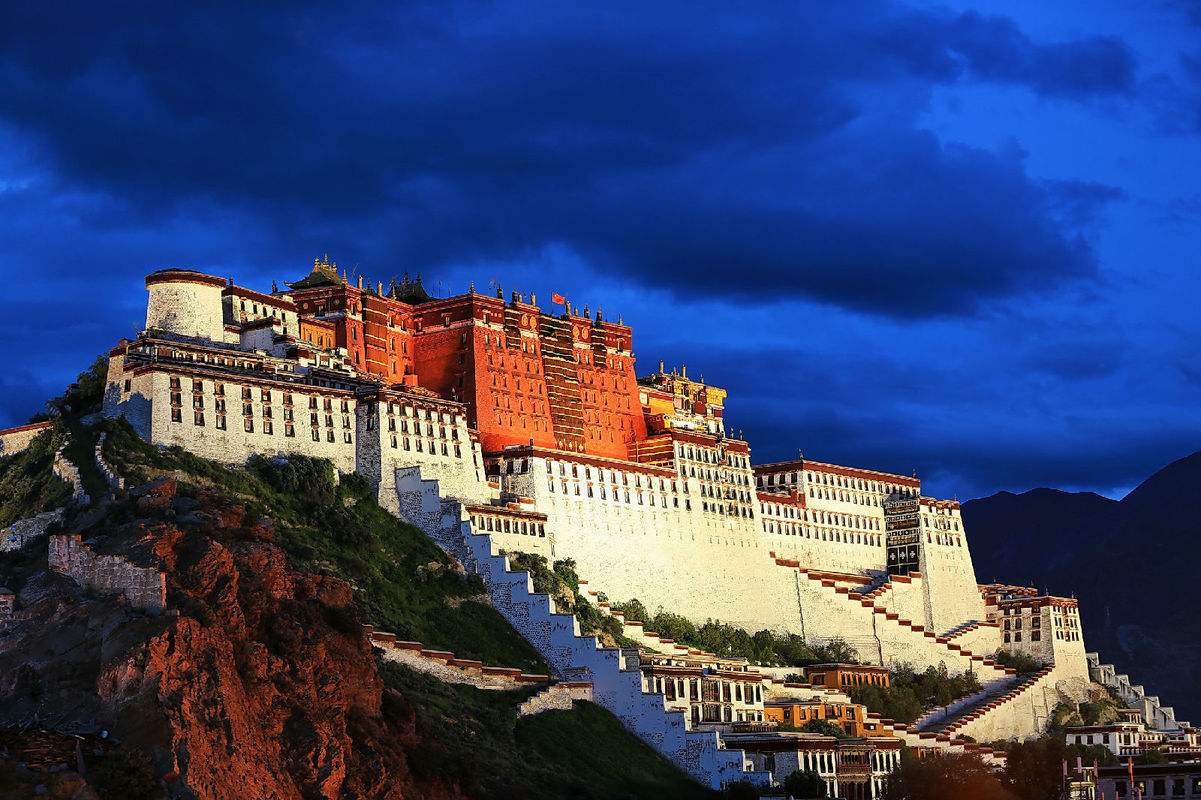24 Hours Hotline: +8613735411378
Email:[email protected]
24 Hours Hotline: +8613735411378
Email:[email protected]

Overview
Potala Palace, known as the resort of Tibetan Buddhism, is the highest belief of all Tibetan Buddhist believers. Located on Mt. Maburi in Lhasa, it is a grand building with the highest elevation in the world, integrating palaces, castles and temples. It is also the largest and most complete ancient palace Castle complex in Tibet.
Background
"Potala" is a Sanskrit transliteration, the original meaning is "the holy land of tibetan buddhist". The Potala Palace was rebuilt during the period of Gushi Khan and the fifth Dalai Lama of the Qing Dynasty in the 17th century. The main colors of the walls were white and red. "Since then, successive Dalai Lamas have expanded one after another and finally become the scale of Potala Palace today." In ancient times, it was not only the monastery of religion, but also the main government agency of Qing Dynasty's ministers stationed in Tibet.
During the Tubo Dynasty
The Potala Palace was built in the 7th century AD. it has a history of 1300 years since Songzanganbu, the Tibetan king of the Tubo Dynasty. At the beginning of the 7th century, Songzan Ganbu moved his capital to Lhasa. In order to marry Princess Wencheng of the Tang Dynasty, he built three nine storey buildings with a total of 1000 palaces, named Potala Palace. When the Tubo Dynasty established by Songzan Ganbu was destroyed, most of the Potala Palace was destroyed by the war. In addition, due to natural disasters such as lightning strikes, the scale of Potala Palace was gradually reduced, and it was even included in the Jokhang Temple as its branch for management.
During the period of Heshuote Khanate
In 1645, Gushi Khan (the supreme ruler of the Tibetan plateau) and sonan Qunpei, Regent of the Gelug Sect, decided to rebuild the Potala Palace in order to consolidate the kingdom of the Qinghai Tibet Plateau and the political and religious government of the Shute Khanate and the Dalai system below. The project was completed in 1693. Since then, the Dalai Lamas have built five additional golden roofs and some ancillary buildings, forming the scale of the Potala Palace today.

Structure
The Potala Palace, 3700 meters above sea level, covers a total area of 360000 square meters, with a total construction area of 130000 square meters. The main building is 117 meters high, with 13 floors in total. Among them, there are palaces, stupa halls, Buddha halls, Scripture halls, monk houses and courtyards.
The White Palace
The White Palace was the Dong palace of the Dalai Lama, was once the office of the former Tibetan local government. It is seven stories high. The White Palace is named for its white exterior wall. The oldest existing building in Potala Palace is Fawang cave. In the 9th century, the Potala Palace was destroyed due to the Tubo civil strife, and only the Fawang cave was left. Inside the cave are statues of himself, Princess Wencheng and princess Chizun of Nepal, which are said to have been made by him before his death.
The Red Palace
The Red Palace is located in the central position of Potala Palace, and the external wall is red. The palace adopts the layout of Mandala, and many Sutra halls and Buddha halls are built around the stupa Hall of Dalai Lamas of all ages, thus connecting with the White Palace. The main building of the Red Palace is the stupa Hall of the Dalai Lama of all ages. There are five palaces, namely the fifth, seventh, eighth, ninth and thirteenth generations.
What to see in Potala Palace
The White Palace
The White Palace is the living place of the Dalai Lama. It has a variety of halls and corridors, which are exquisitely decorated and decorated. There are paintings related to Buddhism on the walls, which are the hands of many famous masters.
The Red Palace
In the Red Palace, there are Buddha statues, Songzan Ganbu statues, thousands of statues of Princess Wencheng and princess Chizun of Nepal, as well as the pagoda of Dalai Lama in the past dynasties, inlaid with gold treasures and decorated with colorful murals. The whole building complex covers an area of more than 100000 square meters, with thousands of houses. The layout is rigorous and well arranged, which reflects the superb skills of Tibetan construction craftsmen.
Mural
There are a large number of murals painted inside the Potala Palace, forming a huge painting gallery. Nearly 200 people have participated in the mural painting, which took more than 10 years. The themes of the murals include the history of Tibetan Buddhism development, the life of the fifth Shida Lama, the process of Princess Wencheng's entering Tibet, the ancient Tibetan architectural images and a large number of Buddhist statues. King Kong is a precious historical painting seal script. There are a large number of precious cultural relics and Buddhist artworks in the palaces of Potala Palace.
The Stupa
The stupa of the fifth Dalai Lama is located in the stupa hall. The tower is 14.85 meters high. It is the highest spiritual Pagoda in the palace. Its body is wrapped in gold and inlaid with various kinds of jewelry and jade. The construction cost 110000 taels of gold.
Treasures Collection
About 200 pieces of cultural relics are on display in the Potala Palace treasure house, including seals, seals, gifts, ancient documents, palm leaf scriptures, Buddha statues, Thangka, and magic wares. The treasure house of Potala Palace looks at the "eight petal lotus paradise" made in the 14th century.
Tips
Visiting the Potala Palace should follow all the taboos of Tibetan Buddhism, such as not wearing hats, not taking photos (referring to taking some "outside scenes" outside the palace after entering the palace), and not trampling on the threshold, etc. All tourists need to complete the visit within 1 hour, so they are not allowed to stay in any place in the palace. After the visit, they can walk to the main gate of Potala Palace by going out from the west gate of Potala Palace and going down the hill behind.
Information
Best time to visit: Mar-Oct
Opening Hours: 09:00-12:00 15:30-16:30
Admission Fee: CNY 200/p/p
visit time: 3 hours
Duration:6-8 Hours
Attractions(Cities): Chengdu Panda Research Base, People's Park, Jinli Ancient Street, Kuanzhai Alley
Tour Style:Immerse yourself in the charm of Chengdu with our Chengdu City Tour. Start at the Chengdu Research Base of Giant Panda Breeding, where you'll get a close look at the adorable giant pandas in their natural habitat and learn about vital conservation efforts. Next, head to People's Park, where you can enjoy a traditional tea experience, soaking in the tranquil local atmosphere. Afterward, take a stroll through Jinli Ancient Street, renowned for its traditional architecture and vibrant market. Finish the tour at the unique blend of history and modernity in Kuanzhai Alley. With round-trip transportation from your Chengdu hotel, this tour offers a seamless and memorable experience, perfect for panda lovers and culture enthusiasts alike!
Duration:6-8 Hours
Attractions(Cities):Chengdu Giant Panda Research Base, Leshan Giant Buddha
Tour Style:This day tour takes you to two of Chengdu’s most iconic attractions: the Chengdu Giant Panda Research Base and the Leshan Giant Buddha. In the morning, you’ll visit the panda base, where you can see the adorable pandas up close in their natural environment. Your guide will provide fascinating details about their behavior, diet, and conservation efforts, helping you gain a deeper understanding of these beloved creatures. In the afternoon, you’ll head to Leshan to marvel at the Leshan Giant Buddha, the largest stone-carved Buddha in the world. Your guide will share the rich history and cultural significance behind this ancient monument, making your visit even more enriching. This tour combines Chengdu’s natural wonders with its deep cultural heritage, ensuring a memorable and insightful experience.
Duration:2 Days 1 Night
Attractions(Cities):Chengdu Panda Base, Renmin Park, Wuhou Temple, Jinli Street, Wenshu Monastery, Chengdu Museum, Tianfu Square
Tour Style:This 2 days Chengdu tour offers a perfect blend of the city’s ancient heritage and modern charm. On Day 1, you’ll visit the Chengdu Panda Base to meet the adorable pandas, followed by a stroll through Renmin Park to experience the local lifestyle. In the afternoon, you’ll explore Wuhou Temple, a historic site steeped in the Three Kingdoms era, and wander through Jinli Ancient Street, a lively area filled with traditional crafts and local snacks. On Day 2, you’ll visit Wenshu Monastery, where full of peaceful Buddhist culture, followed by the Chengdu Museum to discover the city’s rich history. The tour ends at Tianfu Square, where you can feel the vibrant pulse of modern Chengdu. This itinerary, guided by a knowledgeable local, seamlessly combines the city's ancient and contemporary attractions.
Duration:8-9 Hours
Attractions(Cities):Dujiangyan, Qingcheng Mountain
Tour Style:This day tour takes you to two of Sichuan's most fascinating sites: Dujiangyan and Qingcheng Mountain, where nature and culture come together seamlessly. First, you’ll explore the Dujiangyan Irrigation System, a UNESCO World Heritage site that showcases ancient Chinese engineering brilliance. Your guide will explain its history, importance, and how it has shaped water management in the region for over two thousand years. Next, you’ll visit Qingcheng Mountain, a peaceful and spiritual place known as the birthplace of Taoism. Here, you’ll wander through ancient temples and Taoist shrines, surrounded by lush greenery and serene landscapes. This tour offers a unique opportunity to immerse yourself in both natural beauty and rich cultural heritage.
Duration:3 Days 2 Nights
Attractions(Cities):Leshan Giant Buddha, Mount Emei, Chengdu Research Base of Giant Panda Breeding, Renmin Park, Jinli Ancient Street, Kuanzhai Alley
Tour Style:This 3-day Chengdu tour offers the perfect blend of cultural exploration and natural beauty. On Day 1, visit the Chengdu Research Base of Giant Panda Breeding to see China’s iconic pandas up close, then continue to Renmin Park, Jinli Ancient Street, and Kuanzhai Alley, where you’ll experience the city’s lively atmosphere and rich heritage. Day 2 takes you to Leshan, where you’ll marvel at the UNESCO-listed Leshan Giant Buddha, followed by a scenic drive to Mount Emei. On Day 3, explore the sacred beauty of Mount Emei, including the Golden Summit and the stunning Huazang Temple. Throughout the journey, your expert guide will offer fascinating insights, ensuring a smooth, engaging, and unforgettable experience every step of the way.
Wechat: Chinaprivatetour
24 Hours Hotline:
+8613735411378
(Your Privacy is Protected)
1 to 1 tailor-made service from our professional travel advisors for the most sophisticated
Constantly excellent reviews for attraction, hotel and service Competitive price
Local experts provide quality tours Best selected knowledgeable local guides Authentic local restaurants
7*24 hours available to create you a worry-free tour. No Hidden Fees and absolutely no pressure to buy. Secured







